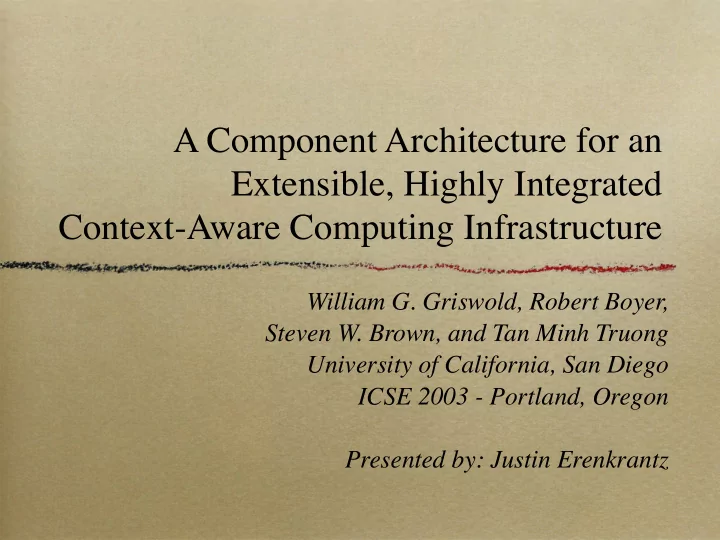

A Component Architecture for an Extensible, Highly Integrated Context-Aware Computing Infrastructure William G. Griswold, Robert Boyer, Steven W. Brown, and Tan Minh Truong University of California, San Diego ICSE 2003 - Portland, Oregon Presented by: Justin Erenkrantz
ActiveCampus at UCSD http://activecampus.ucsd.edu/ Provide location-based applications Also known as services Understand how such systems are used Focus on software systems Geared for mobile devices
Growth presents challenges UCSD will add 10k students in 10 years How to facilitate a cohesive community? Students are increasingly busy Mobile technology is getting affordable Provide tools to help build communities
ActiveCampus Buddy Instant messaging client Annotated with location Display people nearby Display people online
ActiveCampus Map Shows current location Campus map overlayed Indicates building names Location of buddies
What is context? Situation is critical to context Tools can help determine context Alidade: compass, prism, magnifier “Constitute the selection, superimposition, and rendering of representations of task- relevant context”
Needs for Software Architecture Add services easily Anticipate future changes Introduce separation of concerns Desire critical constraints Do not sacrifice integration Performance is critical
Goals for Extensibility Add new services and functionality Introduce new sensor input Incorporate new physical entities Represent locations multiple ways Use new classes of user devices
Building upon Context Toolkit Previous work by Dey and Abowd No useful architectural style presented Desire to have efficient communication Context Toolkit may be too heavy Desire to produce integrated applications Services change over time
ActiveCampus Architecture Centralized, layered system architecture Computation by central server Minimizes demands on portable devices Receive input from sensors (handhelds) Utilize web standards for display Handhelds or desktops
Initial Architecture Layers Data Storage Data Abstraction Object Correlation Mapping data to internal forms Environment Proxy Transport to external devices
Problems with Architecture Entity definitions saw churn and bloat Adding alternate representations hard Services were not decoupled properly Interdependent chain of services Performance was becoming unacceptable Database access became bottleneck
Revised Architecture
Addressing Entity Bloat Intrinsic blurred with presentation People may have the same screen name Performed entity normalization Isolates only essential characteristics Object Correlation is Situation Modeling Tries to determine what is happening
Achieving Low Coupling Services available for subject about object John’s buddy service about Jane Services registered at startup Services provide standard interfaces Defines compatibility between services Compatible services called when needed
Optimizing Performance Prior concerns may impact performance Two-level caching system deployed Inter- and Intra-service caching used Allows for inconsistent and stale data Location ten seconds ago is ‘fine’ Allows minimization of communication
Impact of Architecture Isolate functionality in layers Add rules for combining components Present situational context to users Keys in on how services interact Support of new devices styles difficult
Conclusions Demonstration at UbiComp 2003 Opportunity to use around Seattle Still determining what styles work best Understand tradeoffs in UbiComp Feedback and experience only answer
Recommend
More recommend